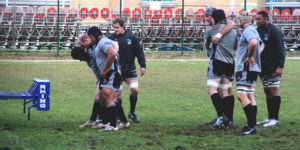Rugby-proof your body for the impacts of tackling and rucking
- Tim Howard
- Training
How do I train my body to withstand the impacts of tackling and rucking?
Unless you only play touch rugby, impacts are an unavoidable part of the game they play in heaven. In fact, the sheer physicality is what draws a lot of players to rugby. There is something uniquely satisfying about putting in a big tackle.=
But impacts can take their toll on your body and could even lead to concussions and other injuries.
Most players find that the effect of impact is less noticeable as the season progresses. They experience less inflammation, less bruising, and less pain. Yet, that’s not much help at the beginning of the season.
Here are a few ways that you can train your body in the off-season to cope with impacts better, and also recover faster from the jarring, bruising, bone-shaking effect of impacts.
How to train yourself to withstand impacts
While all ruggers need to be fit and strong, part of your training should also address the physical demands of impact. In rugby, impact comes from hitting other players as well as hitting the ground. Those impacts can be relatively light, for example when making slight contact with another player, or very heavy, such as being hit by a tackle and then landing on the ground. In terms of force, those impacts vary from as little as 1-3g to a whopping 10+g.
Some players are genetically blessed and seem to be more impact resistant than others, but there are still several things you can do to increase your ability to cope with impact.
Build some muscle
A lot of rugby training literature suggests that ruggers should avoid bodybuilding-type hypertrophy training and, instead, focus primarily on strength and power. The reasoning is that big muscles aren’t necessarily strong or powerful and can sometimes be all show and no go.
However, while slender players can be quick and strong, a lack of muscle mass could mean that impacts are felt more acutely and take longer to recover from.
Building muscle through bodybuilding-style strength training will provide your bones and organs with extra padding – a form of muscular armor. Because of the common impact zones in rugby, ruggers should focus on increasing muscle mass in their shoulders, necks, upper backs, glutes, and thighs.
This doesn’t mean you should replace your strength and power training with hypertrophy training. Instead, consider finishing your performance-based workouts with some muscle-building exercises to get the best of both worlds.
For example:
Squats – 4 sets of 4 reps (strength)
Power cleans – 4 sets of 2 reps (power)
Romanian deadlifts – 3 sets of 6-8 reps (strength/hypertrophy)
Leg extensions and leg curls – 3 sets of 10-12 reps (hypertrophy)
Leg presses – 3 sets of 12-15 reps (hypertrophy/endurance)
This sort of holistic approach to strength training will increase all facets of muscular fitness, including boosting performance and forging some extra impact-resistant muscle mass too.
Do some combat conditioning
Combat conditioning, as the name suggests, a common part of combat sports training, especially MMA and wrestling. As the impacts in rugby are similar to those in combat sports, ruggers can use many of the same methods to prepare their bodies for competition.
There are lots of different combat conditioning exercises to choose from, all of which require a training partner.
Good choices include:
1. Sumo circle
Mark out a five-meter circle and stand in the center with your partner. Bind together like front-row forwards. On the command go, attempt to push your partner out of the ring. Continue for 60 seconds or until there is a winner. Rest a moment and repeat.
Variation – this exercise can also be done by pulling instead of pushing.
2. Pin escape
Lie on your back and have your partner lie across you, pinning you to the floor. Try to free yourself from the pin while they resist your efforts. Continue until you successfully escape or for 60 seconds. Rest a moment and then swap roles.
Variation – start on your front instead of your back
3. Knee wrestling
Kneel facing your partner and hold each other’s shoulders and upper arms. On the command go, try to wrestle your opponent to the floor. Continue for a predetermined time, such as two minutes, or until one of you has scored three falls.
4. Pummeling
Pummeling is an MMA drill designed to prepare you for impact. It can be modified to suit all levels of player simply by going easy on one another or hitting harder.
Using a square or staggered stance, stand close to your partner and grip their upper body in a clinch, and they do the same to you. Pull your partner into you and hit them with your upper body. Try to spread the impact across your shoulders and chest. Swap sides then hit them again. Continue for 60 seconds and then rest.
5. 1 to 1 maul or ruck ball
This rugby specific combat conditioning drill will also improve your offensive and defensive skills. For maul ball, hold a rugby ball and turn your back on your partner. Protect the ball as your partner tries to maul the ball away from you. Keep your back to them to make their job harder. Continue for 60 seconds or until you lose the ball.
The drill is the same for ruck ball, except the defending partner starts lying on the floor.
6. Try some tumbling
As a lot of rugby impacts involve hitting the ground, it makes sense to include some simple tumbling exercises in your impact conditioning training.
You don’t have to try and match the skills of a Cirque du Soleil performer, parkour expert, or Olympic gymnast, but most ruggers should be able to do forward rolls, backward rolls, and side rolls.
Do your tumbling on grass or a padded floor, and take it easy at first, perfecting your technique before you start training to roll too fast. But, once you are moving well, increase your speed and also your height so that you hit the deck with more force.
7. Full contact rugby training
One of the best ways to get used to the effect of impact in competitive rugby is to expose yourself to impacts in training. That means controlled full-contact workouts should be part of rugby preparations.
Needless to say, this is your coaches’ responsibility to organize, but you also need to make sure you show up and work hard, committing to every tackle and ruck. Yes, this is going to hurt, but it’s better to suffer in training than being impact-shy in competition.
Dealing with the aftermath of impacts in rugby
Even if you have successfully conditioned yourself against the effect of impacts, a hard match or full-contact training session can still leave you feeling battered and bruised. Use the following strategies to ease the pain and speed up your recovery.
Epsom salt baths
While there is very little scientific evidence to suggest the Epsom salt baths do much for muscle and joint aches and pains, they are still very popular. This suggests they have a beneficial effect. In water, Epsom salts break down into magnesium and sulfate. These minerals penetrate your skin and may help reduce inflammation and swelling.
Simply put 2-3 cups of Epsom salts in a warm bath and soak your body for 15-20 minutes.
Cold water immersion
Cold water immersion is a common treatment for impact-related pain in rugby. Many professional and amateur teams use things like ice baths and plunge pools after games and full-contact practices.
Cold water immersion is thought to:
- Reduce pain
- Reduce inflammation
- Reduce swelling
- Reduce post-exercise muscle soreness
Cold water immersion works even better when paired with heat – such as a hot shower or bath. This is called contrast therapy. Alternating hot and cold creates a vascular pumping effect, which increases blood flow while removing the substances responsible for pain and inflammation.
Increase your intake of naturally anti-inflammatory foods
The pain caused by rugby impacts is the result of inflammation. Inflammation, in simple terms, is the reddening and swelling of tissue. If you scratch your skin, you will probably see your skin redden, and it may swell to form a welt – that is inflammation.
The habitual use of non-steroidal anti-inflammatory medications like ibuprofen is not recommended, although you can use them for short periods of time. NSAID abuse can lead to problems like heart, kidney, and stomach damage.
Instead, increase your intake of anti-inflammatory foods to help ease the pain of impact. Ten good anti-inflammatory foods are:
- Blueberries – add them to your morning oatmeal
- Wild salmon – a great source of essential fats and protein
- Turmeric – combine with black pepper to increase the bioavailability
- Ginger – grate and add to your curries
- Lemon – mix the juice of ½ lemon with honey and ginger and warm water
- Rosemary – sprinkle on your salads
- Garlic – add fresh garlic to as many of your meals as you can
- Dark chocolate – 70% cocoa solids (or more) is best
- Green tea – also an excellent fat burner and energizer
- Leafy green and brightly colored vegetable – build your meals around vegetables
Sleep it off
Your body tends to do its best anti-inflammatory work while you sleep. With fewer functions to maintain, it has the energy, time, and resources to neutralize inflammation. That’s why you often wake up feeling less sore than when you went to sleep – your body has done some healing overnight.
Because sleep is such a big part of controlling inflammation, all hard-hitting ruggers must get around eight hours of sleep per night. Insufficient sleep can have a big impact on recovery.
Having trouble sleeping? Try taking 2-5 grams of melatonin before going to bed. It’s a safe sleep aid that may also reduce the biological markers of inflammation too.
WRAPPING UP
If you want to be a successful rugger, you need to condition your body to deal with the effect of repeated impacts, and also take steps to recover from them faster. That said, and despite your best efforts, impacts and their effects are unavoidable in rugby, so you’ll also need to develop mental toughness and just “suck it up.”
Of course, improving your agility and ability to slip tackles will mean fewer impacts per game. Given how tough big hits are on your body, trying to avoid even a few impacts could be very helpful.
References:
PubMed: An Evaluation of the Physiological Demands of Elite Rugby Union Using Global Positioning System Tracking Software
https://pubmed.ncbi.nlm.nih.gov/19528840/


